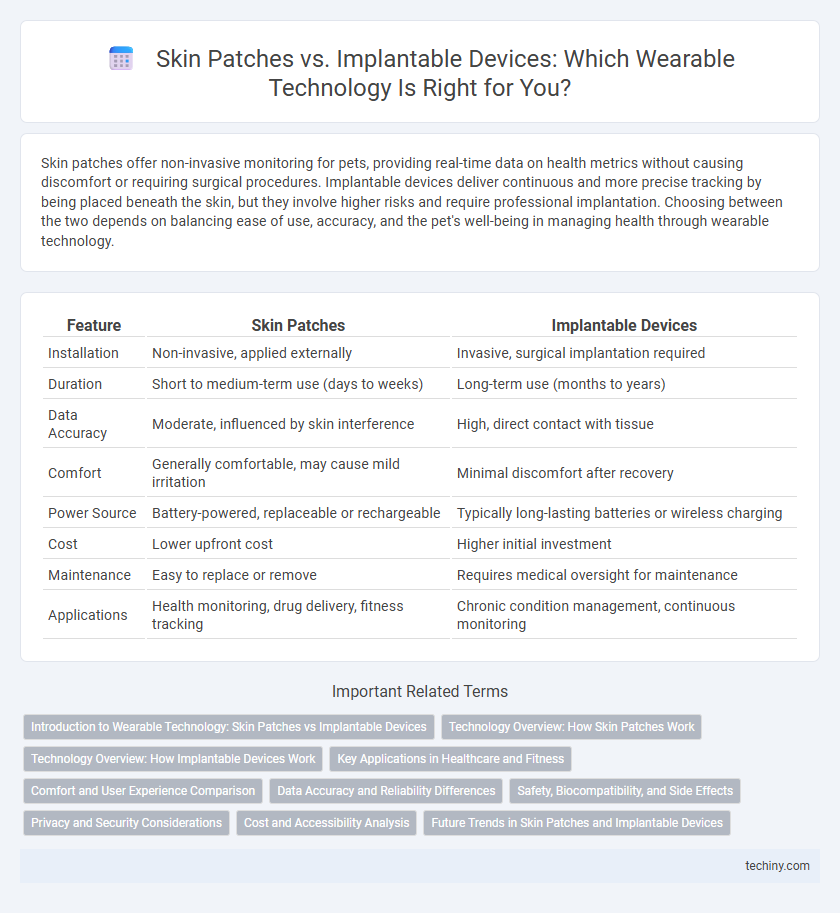Skin patches offer non-invasive monitoring for pets, providing real-time data on health metrics without causing discomfort or requiring surgical procedures. Implantable devices deliver continuous and more precise tracking by being placed beneath the skin, but they involve higher risks and require professional implantation. Choosing between the two depends on balancing ease of use, accuracy, and the pet's well-being in managing health through wearable technology.
Table of Comparison
| Feature | Skin Patches | Implantable Devices |
|---|---|---|
| Installation | Non-invasive, applied externally | Invasive, surgical implantation required |
| Duration | Short to medium-term use (days to weeks) | Long-term use (months to years) |
| Data Accuracy | Moderate, influenced by skin interference | High, direct contact with tissue |
| Comfort | Generally comfortable, may cause mild irritation | Minimal discomfort after recovery |
| Power Source | Battery-powered, replaceable or rechargeable | Typically long-lasting batteries or wireless charging |
| Cost | Lower upfront cost | Higher initial investment |
| Maintenance | Easy to replace or remove | Requires medical oversight for maintenance |
| Applications | Health monitoring, drug delivery, fitness tracking | Chronic condition management, continuous monitoring |
Introduction to Wearable Technology: Skin Patches vs Implantable Devices
Skin patches in wearable technology offer non-invasive, flexible sensors that continuously monitor vital signs like glucose levels and hydration, providing user-friendly health tracking. Implantable devices, embedded beneath the skin, deliver precise, real-time data and enable advanced functionalities such as drug delivery and neural stimulation. Both technologies drive innovation in personalized medicine by enhancing accuracy, comfort, and long-term health management.
Technology Overview: How Skin Patches Work
Skin patches utilize flexible electronics embedded with biosensors that continuously monitor physiological signals such as glucose levels, hydration, or heart rate through the skin's surface. These devices employ microfluidic channels and epidermal adhesives to ensure accurate data collection in real-time without invasive procedures. Integration with wireless communication modules allows seamless transmission of health metrics to smartphones or medical databases for immediate analysis and alerts.
Technology Overview: How Implantable Devices Work
Implantable devices function by integrating seamlessly beneath the skin, utilizing microelectronic components to monitor physiological signals and deliver targeted therapies in real-time. These devices employ biocompatible materials and wireless communication protocols such as Bluetooth Low Energy or near-field communication to transmit data to external receivers or smartphones. Advanced sensors within implantables detect biochemical markers, electrical activity, or mechanical changes, enabling continuous health monitoring and precise medical interventions.
Key Applications in Healthcare and Fitness
Skin patches offer non-invasive monitoring of vital signs such as glucose levels, hydration, and heart rate, making them ideal for continuous health and fitness tracking. Implantable devices provide precise, long-term data collection for chronic conditions, enabling real-time medication delivery and biometric monitoring within the body. Both technologies advance personalized healthcare by enhancing disease management, fitness optimization, and early detection of health anomalies.
Comfort and User Experience Comparison
Skin patches offer superior comfort and ease of use compared to implantable devices due to their non-invasive application and flexibility on the skin surface. Implantable devices, while providing continuous monitoring, often cause discomfort and require surgical procedures, which can impact long-term user experience negatively. User preference generally favors skin patches for daily wear because they are lightweight, breathable, and cause minimal irritation, enhancing overall compliance and satisfaction.
Data Accuracy and Reliability Differences
Skin patches offer non-invasive monitoring with moderate data accuracy suitable for daily health tracking, yet they can be affected by external factors like sweat and movement. Implantable devices provide superior data reliability and continuous real-time monitoring due to direct tissue interface, minimizing signal interference. The choice between these technologies depends on the required precision and application, with implantables favored for critical medical diagnostics.
Safety, Biocompatibility, and Side Effects
Skin patches offer a safer and more biocompatible option compared to implantable devices, minimizing risks of infection and adverse immune responses due to their non-invasive nature. Implantable devices, while providing continuous monitoring and precise data collection, carry higher risks of complications such as inflammation, tissue damage, and potential rejection by the body's immune system. Advances in materials science focus on enhancing biocompatibility and reducing side effects, improving the longevity and safety profile of both wearable skin patches and implantable technologies in medical applications.
Privacy and Security Considerations
Skin patches offer non-invasive data collection with lower risk of unauthorized access compared to implantable devices, which pose heightened privacy concerns due to their constant connectivity and potential for continuous monitoring. Implantable devices require robust encryption protocols and secure authentication methods to safeguard sensitive health data from hacking or unauthorized extraction. Ensuring compliance with healthcare data regulations such as HIPAA and GDPR is critical for both technologies to maintain user trust and data integrity.
Cost and Accessibility Analysis
Skin patches offer a cost-effective and widely accessible solution for wearable technology, as their non-invasive design reduces manufacturing complexity and eliminates the need for surgical procedures. Implantable devices, while providing continuous and precise monitoring, involve higher upfront costs due to surgical implantation, specialized materials, and follow-up care, making them less accessible to the general population. The affordability and ease of use of skin patches contribute to broader market adoption and frequent device replacement cycles compared to implantables.
Future Trends in Skin Patches and Implantable Devices
Future trends in skin patches emphasize advanced biosensors enabling continuous health monitoring with enhanced accuracy, while implantable devices focus on miniaturization and wireless connectivity for real-time data transmission and personalized therapy. Innovations include flexible materials for skin patches that improve comfort and adhesion, and biocompatible, biodegradable components in implantables that reduce long-term complications. Integration of AI-driven analytics and energy-efficient power sources will further enhance the functionality and user experience of both wearable and implantable medical technologies.
Skin Patches vs Implantable Devices Infographic

 techiny.com
techiny.com